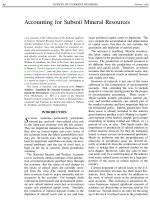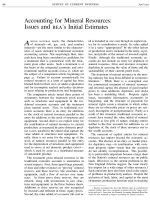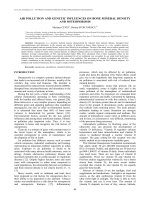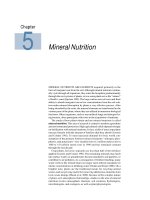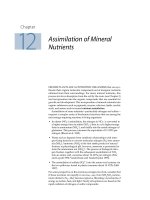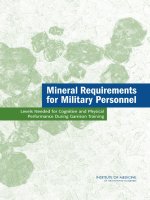50427699 mineral geology
Bạn đang xem bản rút gọn của tài liệu. Xem và tải ngay bản đầy đủ của tài liệu tại đây (5.68 MB, 22 trang )
EARTH MATERIALS 2.07
Professor Peter Doyle
Course aims
• Aims to understand:
– the basic nature of the principal rock forming
minerals
– Igneous, sedimentary and metamorphic rocks
• Provides:
– the means of identifying & differentiating minerals
and rocks in hand specimen
• Practicals:
– Provide experience of handing and describing
geological materials
Reading and Assessment
Reading:
• Press, F. & Siever, R. 1994. Understanding Earth,
Freeman
Assessment:
• Practical file (worth 20% overall, to include all
practicals)
• Examination (80%), with pass mark of 40% overall.
Course outline
Part 1: Minerals
• Session 1: Introduction to minerals & crystal structures
• Session 2: Use of physical properties in the identification of
minerals in hand specimens
• Session 3: Silicate minerals: their nature and general properties
• Session 4: Non-silicate minerals their nature and general
properties
Part 2: Rocks
• Session 5: Introduction to rocks and the rock cycle: igneous
rocks
• Session 6: Sedimentary rocks – Clastics
• Session 7: Sedimentary rocks – Carbonates
• Session 8: Metamorphic rocks – general characteristics USE IN
THE PRACTICALS
MINERALS
•Minerals are naturally occurring, homogeneous,
crystalline solid with a definite chemical
composition
Halite – NaCl
Biotite – K2(Mg,Fe2+)4 (Fe3+,Al,)2(Si6 Al2 O20)
(OH,F)4
•Minerals usually form by inorganic processes but
some may be biogenic in origin
Quartz: primary rock forming mineral, simple silicate
Olivine: primary rock forming mineral, complex silicate
Other Minerals: Pyrite,
Pyrite an iron sulphide
Biogenic minerals: Modern shell debris composed of
carbonate & silica minerals
ROCKS
• A rock is:
• a naturally formed aggregate of mineral matter
constituting a significant part of the Earth's crust.
• Rocks can be consolidated or non-consolidated
• Rocks can be monomineralic or an aggregate
of mineral species
• Rocks usually form by inorganic processes but
some may be biogenic in origin
Granite: polished section showing aggregate of four
interlocking and different coloured minerals
Crushed rocks
Cement matrix
Concrete: non-natural aggregate of other rocks set in a
matrix
Coal - biogenic
Evaporite - inorganic
Limestone - biogenic
Biogenic and
inorganic
sedimentary rocks
Part 1: Minerals
• A mineral is:
• A naturally occurring, crystalline solid with a
definite chemical composition
• Structurally homogeneous
– Atomic structure is continuous and
constant throughout the mineral structure
– Mineral structure expressed as the Unit
Cell
The Unit Cell
• Unit Cell is the smallest 3D repeating unit of a
crystal structure representative of its:
• atomic structure
• chemical composition
• crystal symmetry
• Unit Cell is a regularly ordered arrangement
of atoms with a fixed geometry relative to one
another
• The atoms are arranged in a ‘box’ with
parallel sides, the unit cell, which is repeated
by simple translations to make up the crystal
• Unit cell dimensions measured in angstroms
with 1A = 10-10m
TEM image of Cordierite
(Mg2Al4Si5O18) showing
ordered structure typical of
crystalline structures
Micro
20A
Macrocrystals of Cordierite showing
well developed flat crystal faces that
characterise crystals in their macro
form
Macro
Crystal Systems: common groups of symmetry
Crystal symmetry is defined
by:
• Planes of symmetry
• Axes of rotation
• Axes of inversion
All properties of a crystal
substance conform to
symmetry
Symmetry is the defining
property of a crystal
Unit cell dimensions of the seven crystal systems
The crystal systems can be defined by their stacked unit cells
•
•
•
•
•
•
•
•
CUBIC
a = b = c; α = β = γ = 90
TETRAGONAL
a = b ≠ c; α = β = γ = 90
ORTHORHOMBIC
a ≠ b ≠ c; α = β = γ = 90
MONOCLINIC
a ≠ b ≠ c; α = γ = 90 β > 90
TRICLINIC
a ≠ b ≠ c; α ≠ β ≠ γ ≠ 90
HEXAGONAL
a = b ≠ c; α = β = 90; γ =120
TRIGONAL – Hexagonal
a = b ≠ c; α = β = 90; γ =120
TRIGONAL – Rhombohedral
a = b = c; α = β = γ ≠ 90 < 120
Where a, b, and c are the unit cell axes
dimensions and α, β, and γ are the
inclination angles of the axes in the unit
cell.
Crystal Structures
All crystal structures can be envisaged as:
• the packing together of spherical ions/atoms
• bonded by ionic and/or covalent and/or metallic bonds
Ionic bond:
bond
• Electrical attraction between
ions of opposite charge (Na+, Cl-)
•90% minerals are ionic
compounds
Covalent bond:
• shared electrons where
electrons not readily lost/gained
•E.g. Diamond
Metallic bond:
• free-electron sharing in metallic
atoms (loose electrons)
e.g. NaCl - Salt
Crystal Growth
• Crystal growth can be envisaged as addition of unit
cells in three dimensions
•
If this occurs at the same rate in all directions the
shape of the unit cell will be retained in the macro
crystals
•
If the rate of addition of unit cells is not the same
in all directions the shape of the macro crystals
need not reflect the unit cell shape
•
The symmetry of the macro crystals ALWAYS
reflects at least the minimum symmetry of the
crystal system of the unit cell.
Calcite structure
Ionic bond
Calcite rhomb
Unit cell
Calcite crystal habit
Calcite
Crystal
Unit Cell of
pyrite
Pyrite
Unit cell
Pyrite
crystals: ideal
growth
Pyrite nodular
aggregate:
confined growth


